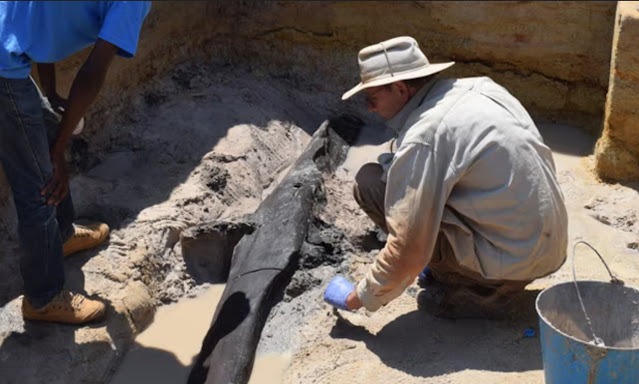In the heart of southern Africa, beneath the vast African sky and shrouded in the dense forests of Zambia, an ancient man made wooden structure was discovered, that is challenging how we see human history. Dating back an astonishing 476,000 years, this remarkable structure, once hidden in plain sight, challenges the very foundations of our understanding of ancient human history.
The Discovery
The story of this remarkable find begins in the 1960s when British archaeologist Dr. Edward Simpson embarked on an expedition to explore the rich archaeological heritage of Zambia. He and his team stumbled upon something that left them dumbfounded – a network of stone structures that appeared to be the remnants of an ancient city. This discovery, initially dismissed as a geological anomaly, would later prove to be an archaeological treasure trove of immense significance.
The Challenge to Modern Ideas
The conventional timeline of human history, as we understand it today, is rooted in the idea that Homo sapiens originated in Africa roughly 200,000 years ago and then gradually evolved into more complex societies, with agriculture and civilization emerging only within the last 10,000 years. The 476,000-year-old structure in Zambia challenges this timeline, inviting us to reconsider the depth of human history.
Complexity Beyond Expectations
The newfound ruins, however, predate the end of the nomadic period in human history by hundreds of thousands of years, raising compelling questions about the intellectual and technological prowess of their creators. How could a society have achieved such a level of complexity at a time when conventional history suggests humanity was living a relatively primitive existence?
One of the most intriguing aspects of the Zambia discovery is the evidence of early agriculture. The site contains remnants of cultivated crops, leading experts to believe that this ancient society may have practiced agriculture. This revelation challenges the conventional belief that agriculture emerged much later in human history, coinciding with the shift from hunter-gatherer societies to settled, agricultural civilizations.
The implications of the 476,000-year-old structure in Zambia extend beyond challenging the timeline of human history. They force us to reconsider the capacity of early humans for advanced culture and societal organization. If we accept the reality of this ancient civilization, we must rewrite the narrative of human development, recognizing that complex societies may have arisen and fallen long before our current understanding.
So Who Built these Structures?
One of the most perplexing aspects of this discovery is the identity of the builders. The structures give us tantalizing clues about their creators, but we have yet to find concrete evidence pointing to the exact species responsible. While we cannot definitively identify the builders, it is highly likely that they were a species similar to Homo Naledi, an early hominin species known to have lived in Africa between 335,000 - 235,000 years ago.
The 476,000-year-old structure found in Zambia is a testament to the ever-evolving nature of human history and our limited understanding of our past. This remarkable discovery challenges modern ideas about ancient human history by suggesting the existence of an advanced civilization that thrived hundreds of thousands of years ago, forcing us to reevaluate the capabilities and achievements of early humans. The significance of this find reverberates through the academic world, pushing us to expand the horizons of our knowledge and inspiring a new era of exploration and discovery in the field of archaeology. As we delve deeper into the mysteries of this ancient civilization, one thing is certain: the past holds more secrets than we ever imagined, waiting to challenge and reshape our understanding of human history.



0 comments:
Post a Comment